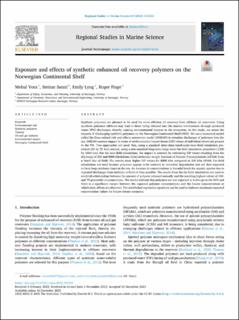| dc.contributor.author | Vora, Mehul Arun | |
| dc.contributor.author | Sanni, Steinar | |
| dc.contributor.author | Lyng, Emily | |
| dc.contributor.author | Flage, Roger | |
| dc.date.accessioned | 2024-02-06T12:13:35Z | |
| dc.date.available | 2024-02-06T12:13:35Z | |
| dc.date.created | 2024-01-02T15:04:22Z | |
| dc.date.issued | 2023-12 | |
| dc.identifier.citation | Vora, M.A, Sanni, S., Lyng, E. & Flage, R. (2023) Exposure and effects of synthetic enhanced oil recovery polymers on the Norwegian Continental Shelf. Regional Studies in Marine Science, 69, 103334 | en_US |
| dc.identifier.issn | 2352-4855 | |
| dc.identifier.uri | https://hdl.handle.net/11250/3115905 | |
| dc.description.abstract | Synthetic polymers are planned to be used for more efficient oil recovery from offshore oil reservoirs. Using synthetic polymers offshore may lead to these being released into the marine environment through produced water (PW) discharges, thereby causing environmental impacts in the ecosystem. In this study, we assess the impacts of discharging synthetic polymers on the Norwegian Continental Shelf (NCS). We use a numerical model called the Dose-related risk and effects assessment model (DREAM) to simulate discharges of polymers into the sea. DREAM assesses impact in terms of environmental impact factor (EIF) values of individual chemicals present in the PW. Two approaches are used: first, using a standard short-time/small-scale/near-field simulation procedure (50 by 50 km); second, using a non-standard long-term/large-scale/far-field simulation procedure (1200 by 1800 km). For the near-field simulations, the impact is assessed by estimating EIF values resulting from the discharge of 200 and 8000 kilodaltons (kDa) molecular weight fractions of Anionic Polyacrylamide (APAM) from a North Sea oil field. The results show higher EIF values for 8000 kDa compared to 200 kDa APAM. Far-field simulations are used because polymers appear to be resistant to microbial degradation and are thus expected to have long residence times in the sea. An increase in concentrations to harmful levels for aquatic species due to repeated discharges from multiple oilfields is thus possible. The results from the far-field simulations are used to establish relationships between the amount of polymer released annually and the resulting highest values of 100- and 75-percentile concentrations. The results indicate that polymers are not expected to build-up on the NCS and there is a significant margin between the expected polymer concentrations and the lowest concentrations at which toxic effects are observed. The established regression equations can be used to indicate maximum expected concentration values for future release scenarios. | en_US |
| dc.language.iso | eng | en_US |
| dc.publisher | Elsevier Ltd. | en_US |
| dc.rights | Navngivelse 4.0 Internasjonal | * |
| dc.rights.uri | http://creativecommons.org/licenses/by/4.0/deed.no | * |
| dc.subject | syntetiske polymer | en_US |
| dc.subject | oljebrønner | en_US |
| dc.subject | risikoanalyse | en_US |
| dc.title | Exposure and effects of synthetic enhanced oil recovery polymers on the Norwegian Continental Shelf | en_US |
| dc.type | Peer reviewed | en_US |
| dc.type | Journal article | en_US |
| dc.description.version | publishedVersion | en_US |
| dc.rights.holder | © 2023 The Author(s). | en_US |
| dc.subject.nsi | VDP::Teknologi: 500::Berg‑ og petroleumsfag: 510::Petroleumsteknologi: 512 | en_US |
| dc.source.volume | 69 | en_US |
| dc.source.journal | Regional Studies in Marine Science | en_US |
| dc.identifier.doi | 10.1016/j.rsma.2023.103334 | |
| dc.identifier.cristin | 2219163 | |
| dc.relation.project | Norges forskningsråd: 230303 | en_US |
| dc.source.articlenumber | 103334 | en_US |
| cristin.ispublished | true | |
| cristin.fulltext | original | |
| cristin.qualitycode | 1 | |

